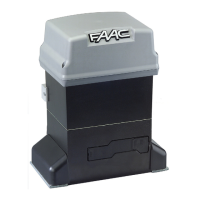746 C - 844 C 40 532150 - Rev.A
Translation of the original instructions
ENGLISH
8.4 BUS 2EASY DEVICES
It is possible to connect FAAC Bus 2Easy devices (pho-
tocells, sensitive edges, control devices) to the board.
i
If no BUS 2easy accessories are used, leave connector
2EASY free (do not bridge).
CONNECTION
Connect the devices to the 2EASY terminal board.
i
Do not exceed the maximum load of 500 mA.
The overall length of the Bus 2Easy cables must not
exceed 100 m.
The connection on the BUS line does not require a
matching polarity connection.
Bus 2Easy Bus 2Easy Bus 2Easy
2EASY
BUS 2EASY PHOTOCELLS
!
Photocells are additional type D detection devices
(according to EN 12453) that reduce the likelihood of
contact with the moving leaf. The photocells are not
safety devices according to standard EN 12978. Detec-
tion devices used as safety accessories (e.g. sensitive
edges) to protect against a hazard, must comply with
standard EN 12978.
Type of use:
FSW CL Photocell active during closing
FSW OP
Photocell active during opening
FSW OP/CL
Photocell always active
OPEN
Photocell for OPEN A
FSW OP
FSW CL
i
The action carried out when the photocells are triggered
depends on the operating logic of the automation.
1. Assign an address to the BUS 2easy photocells by
setting the four DIP switches on both the transmit-
ter and the corresponding receiver ( see table).
i
The transmitter and receiver of a pair of photocells must
have the same DIP switch settings.
There must never be more than one pair of photocells
with the same DIP switch setting. If there is more than
one pair of photocells with the same DIP switch setting,
it generates a conflict error on the board and prevents
the automation from working. Detection devices do not
generate conflicts with control devices and vice versa.
2. Register the BUS 2easy devices (§ specific section).
3. Check the Bus 2Easy devices (§ specific section)
and make sure that the automation operates ac-
cording to the type of photocell installed.
3 Assigning an address to Bus 2Easy photocells
Key: 0=OFF , 1=ON
1 0 0 0
FSW CL
1 0 0 1
1 0 1 0
1 0 1 1
1 1 0 0
1 1 1 0
0 0 0 0
FSW OP
0 0 0 1
0 0 1 0
0 0 1 1
0 1 1 1
0 1 0 0
FSW OP/CL
0 1 0 1
1 1 1 1 OPEN
BUS 2EASY SENSITIVE EDGES
Type of use:
CL EDGE Sensitive edge active during closing
OP EDGE
Sensitive edge active during opening
The activation of a sensitive edge causes the direction
of movement to reverse as specified in advanced
programming:
- complete
IP = no
- partial (2 s) IP = Y
1. Assign an address to the device electronics by
setting the four DIP switches ( see table).
i
No two devices should have the same DIP switch set-
tings. If there are multiple devices with the same DIP
switch setting, it generates a conflict error on the board
and prevents the automation from working. Detection
devices do not generate conflicts with control devices
and vice versa.
2. Register the BUS 2easy devices (§ specific section).
3. Check the Bus 2Easy devices (§ specific section)
and make sure that the sensitive edges are working
correctly. When the gate is moving, use an obstacle
to activate the sensitive edge and make sure that
the automation operates according to the type of
sensitive edge installed.
ON
1 2 3 4

